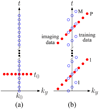Improving temporal resolution of pulmonary perfusion imaging in rats using the partially separable functions model
- PMID: 20564601
- PMCID: PMC2946504
- DOI: 10.1002/mrm.22500
Improving temporal resolution of pulmonary perfusion imaging in rats using the partially separable functions model
Abstract
Dynamic contrast-enhanced MRI (or DCE-MRI) is a useful tool for measuring blood flow and perfusion, and it has found use in the study of pulmonary perfusion in animal models. However, DCE-MRI experiments are difficult in small animals such as rats. A recently developed method known as Interleaved Radial Imaging and Sliding window-keyhole (IRIS) addresses this problem by using a data acquisition scheme that covers (k,t)-space with data acquired from multiple bolus injections of a contrast agent. However, the temporal resolution of IRIS is limited by the effects of temporal averaging inherent in the sliding window and keyhole operations. This article describes a new method to cover (k,t)-space based on the theory of partially separable functions (PSF). Specifically, a sparse sampling of (k,t)-space is performed to acquire two data sets, one with high-temporal resolution and the other with extended k-space coverage. The high-temporal resolution training data are used to determine the temporal basis functions of the PSF model, whereas the other data set is used to determine the spatial variations of the model. The proposed method was validated by simulations and demonstrated by an experimental study. In this particular study, the proposed method achieved a temporal resolution of 32 msec.
Figures




Similar articles
-
Comparison of models and contrast agents for improved signal and signal linearity in dynamic contrast-enhanced pulmonary magnetic resonance imaging.Invest Radiol. 2015 Mar;50(3):174-8. doi: 10.1097/RLI.0000000000000122. Invest Radiol. 2015. PMID: 25501016 Free PMC article. Clinical Trial.
-
Time-resolved 3D pulmonary perfusion MRI: comparison of different k-space acquisition strategies at 1.5 and 3 T.Invest Radiol. 2009 Sep;44(9):525-31. doi: 10.1097/RLI.0b013e3181b4c252. Invest Radiol. 2009. PMID: 19652608
-
Three-dimensional pulmonary perfusion MRI with radial ultrashort echo time and spatial-temporal constrained reconstruction.Magn Reson Med. 2015 Feb;73(2):555-64. doi: 10.1002/mrm.25158. Epub 2014 Mar 6. Magn Reson Med. 2015. PMID: 24604452 Free PMC article.
-
[Magnetic resonance imaging of pulmonary perfusion. Technical requirements and diagnostic impact].Radiologe. 2009 Aug;49(8):739-47. doi: 10.1007/s00117-009-1880-5. Radiologe. 2009. PMID: 19626308 Review. German.
-
K-Bayes reconstruction for perfusion MRI II: modeling and technical development.J Digit Imaging. 2010 Aug;23(4):374-85. doi: 10.1007/s10278-009-9184-x. Epub 2009 Mar 10. J Digit Imaging. 2010. PMID: 19274427 Free PMC article. Review.
Cited by
-
Manifold recovery using kernel low-rank regularization: application to dynamic imaging.IEEE Trans Comput Imaging. 2019 Sep;5(3):478-491. doi: 10.1109/tci.2019.2893598. Epub 2019 Jan 24. IEEE Trans Comput Imaging. 2019. PMID: 33768137 Free PMC article.
-
GRASP-Pro: imProving GRASP DCE-MRI through self-calibrating subspace-modeling and contrast phase automation.Magn Reson Med. 2020 Jan;83(1):94-108. doi: 10.1002/mrm.27903. Epub 2019 Aug 10. Magn Reson Med. 2020. PMID: 31400028 Free PMC article.
-
The Influence of Data-Driven Compressed Sensing Reconstruction on Quantitative Pharmacokinetic Analysis in Breast DCE MRI.Tomography. 2022 Jun 14;8(3):1552-1569. doi: 10.3390/tomography8030128. Tomography. 2022. PMID: 35736876 Free PMC article.
-
High-resolution dynamic speech imaging with joint low-rank and sparsity constraints.Magn Reson Med. 2015 May;73(5):1820-32. doi: 10.1002/mrm.25302. Epub 2014 Jun 9. Magn Reson Med. 2015. PMID: 24912452 Free PMC article.
-
Accelerated High-Dimensional MR Imaging With Sparse Sampling Using Low-Rank Tensors.IEEE Trans Med Imaging. 2016 Sep;35(9):2119-29. doi: 10.1109/TMI.2016.2550204. Epub 2016 Apr 12. IEEE Trans Med Imaging. 2016. PMID: 27093543 Free PMC article.
References
-
- Thompson HK, Starmer CF, Whalen RE, McIntosh HD. Indicator Transit Time Considered as a Gamma Variate. Circ Res. 1964;14:502–515. - PubMed
-
- Berthezene Y, Vexler V, Clement O, Muhler A, Moseley ME, Brasch RC. Contrast-enhanced MR imaging of the lung: assessments of ventilation and perfusion. Radiology. 1992;183:667–672. - PubMed
-
- Presson RG, Todoran TM, B J DeWitt IFM, Wagner WW. Capillary Recruitment and Transit Time in the Rat Lung. J Appl Physiology. 1997;83:543–549. - PubMed
-
- Balogh L, Andoncs G, Thuroczy J, Nemeth T, Lang J, Bodoi K, Janoki GA. Veterinary Nuclear Medicine. Scintigraphical Examinations - a Review. Acta Vet Brno. 1999;68:231–239.
-
- Hatabu H, Tadamura E, Levin DL, Chen Q, Li W, Kim D, Prasad PV. Quantitative Assessment of Pulmonary Perfusion with Dynamic Contrast-Enhanced MRI. Magn Reson Med. 1999;42:1033–1038. - PubMed
Publication types
MeSH terms
Grants and funding
LinkOut - more resources
Full Text Sources

